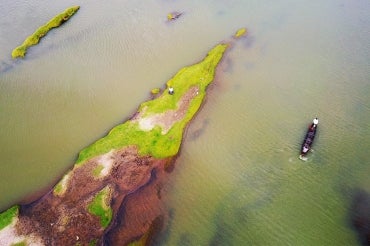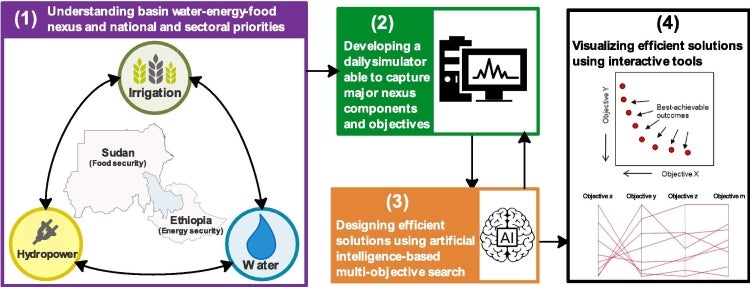U of T expert navigates water, food and energy challenges for large river basins

Assistant Professor Mohammed Basheer’s research aims to integrate AI, engineering, social sciences and stakeholder engagement into a holistic model of water resource management (photo by Waddah Hago)
Published: April 2, 2024
The Nile is one of the world’s longest rivers, providing water and hydropower to millions of people.
But with nearly 86 percent of the water that flows into the Nile originating in Ethiopia – and nearly all of it consumed in Egypt and Sudan – there are complex dynamics surrounding resource management and reconciling the needs of countries along the north-flowing river.
The University of Toronto's Mohammed Basheer is looking to address this by integrating AI, engineering, social sciences and stakeholder engagement into a holistic model of water resource management.
An assistant professor in the department of civil and mineral engineering in the Faculty of Applied Science & Engineering, Basheer’s work focuses on the water-energy-food nexus, incorporating political and economic dynamics to improve policy and planning across the region.
This interdisciplinary approach is laid out in a framework, developed with partners at the International Food Policy Research Institute and published in the Journal of Hydrology, that provides a blueprint to navigate the interplay between water, energy and food resources at basin scale.
“It makes sense to manage these resources together; if you aren’t thinking holistically, then interventions may produce trade-offs,” says Basheer.
Concerns over water availability downstream have mounted ever since Ethiopia began construction of the Grand Ethiopian Renaissance Dam (GERD) in 2011. The project could double electricity generation in a country where around 45 per cent of the population didn’t have access to electricity as of 2021 – but it’s expected to affect the inter- and intra-annual variabilities of the Nile flow, potentially affecting water supply and hydroelectric power downstream in Egypt and Sudan.

Currently, water supply from the Nile accounts for around 97 per cent of Egypt’s freshwater resources. A significant amount of irrigation and hydro in Sudan is sourced from the river as well.
“It is difficult to develop fixed long-term plans given the uncertainties stemming from the variability and shifts in the Nile flow,” Basheer said, highlighting the imperative for adaptive strategies.
The framework created by Basheer and partners comprises four steps.
The first involves understanding the food-water-energy nexus by consulting with stakeholders to identify key priorities and trade-offs.
The second stage is simulation – Basheer and colleagues developed sophisticated models to encapsulate the complexities of the Blue Nile River basin. These models serve as virtual laboratories that enable policy-makers to explore scenarios and interventions.
The third stage leverages AI algorithms to identify patterns and recommend strategies to balance trade-offs between water, energy and food performance.
Stakeholder engagement and communication is the final stage, with visualizations and online tools used to communicate findings and actionable insights to policy-makers.
The work has resulted in partnerships with the International Food Policy Research Institute and other government and academic institutions, with Basheer – a recent addition to U of T Engineering faculty – keen to apply his methodology to projects in Ontario and across Canada.
“This interdisciplinary approach is applicable to various water resource systems internationally, and I hope it results in policy and operational enhancements,” he said.
“I envision a future where water resource systems are planned and managed holistically, incorporating engineering, economic, social and political dimensions.”



